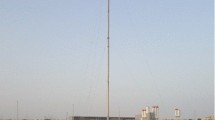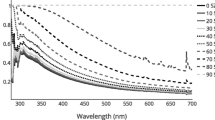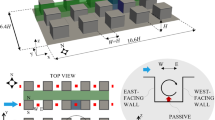Abstract
An approximate sky view factor (SVF) has been developed, which is capable of estimating the mean rate of net longwave radiant energy loss from urban street canyons. Reduced scale models of typical canyon geometries were used in outdoor tests to verify the predictions of radiant fluxes obtained using the proposed SVF.
Air-surface temperature differences from the scale models are used together with hypothesized within-canyon airflow patterns to determine some quantitative characteristics of the wind field in canyons. Simple correlations are proposed for the relationship between mean in-canyon and pedestrian-level flow speeds on the one hand, and the ambient (above roof-level) wind speed on the other hand. As expected, the height/width ratio of a canyon controls the form and magnitude of the flow within.
Similar content being viewed by others
Abbreviations
- a :
-
constant used in Equation (3) for Brunt number calculation
- A :
-
area of the surface (m2)
- b :
-
constant used in Equation (3) for Brunt number calculation
- B :
-
longwave radiosity at the surface (W m−2)
- Br:
-
Brunt number
- F i-j :
-
view factor from surfacei to surfacej
- FA :
-
area of the built-up portion of a neighbourhood (m2)
- H :
-
average height of canyon walls (cm)
- h c :
-
convective heat transfer coefficient at the surface (W m−2 K−1)
- H i :
-
longwave irradiance at surfacei (W m−2)
- L I :
-
incoming longwave radiative flux at the surface (W m−2)
- L O :
-
outgoing longwave radiative flux at the surface (W m−2)
- L * :
-
net rate of outgoing longwave radiation from the surface (W m−2)
- N :
-
the number of surfaces forming an enclosure
- Q :
-
overall net radiatn energy outflow from the canyon (W)
- \(\bar q\) :
-
approximate mean rate of radiant energy loss to the atmosphere at the canyon facets (W m−2)
- Q G :
-
conductive heat flux (W m−2)
- Q H :
-
convective heat flux at the surface (W m−2)
- canyon:
-
mean value over the canyon surfaces
- e, w :
-
east wall, west wall
- f :
-
canyon floor
- t :
-
canyon top opening
- w1, w2 :
-
wall 1, wall 2
References
Arens, E. and Bosselmann, P.: 1989, ‘Wind, Sun and Temperature-Predicting the Thermal Comfort of People in Outdoor Spaces’,Building and Environment 24, 315–320.
Arnfield, A. J.: 1990, ‘Canyon Geometry, the Urban Fabric and Nocturnal Cooling: A Simulation Approach’,Physical Geog. 11, 220–239.
ASHRAE Handbook: 1983,1981 Fundamentals, ASHRAE, Inc., Fourth Printing, Atlanta.
Barring, L., Mattsson, J. O., and Lindqvist, S.: 1986, ‘Canyon Geometry, Street Temperatures and Urban Heat Island in Malmo, Sweden’,J. Climatol. 5, 433–444.
Clarke, J. A.: 1985,Energy Simulation in Building Design, Adam Hilger Ltd., Bristol.
DePaul, F. T. and Sheih, C. M.: 1986, ‘Measurements of Wind Velocities in a Street Canyon’,Atmos. Environ. 20, 455–459.
Holden, T. S.: 1961, ‘Calculation of Incident Low Temperature Radiation’,ASHRAE Journal, 51–54.
Hotchkiss, R. S. and Harlow, F. H.: 1973, ‘Air Pollution Transport in Street Canyons’, Report by Los Alamos Scientific Laboratory for U.S. Environmental Protection Agency, EPA-R4-73-029, NTIS PB-233 252.
Hoydysh, W. G. and Dabbert, W. F.: 1988, ‘Kinematics and Dispersion Characteristics of Flow in Asymmetric Street Canyons’,Atmos. Environ. 22, 2677–2689.
Johnson, D. B.: 1985, ‘Urban Modification of Diurnal Temperature Cycles in Birmingham’,J. Climatol. 5, 221–225.
Johnson, T. G., Oke, T. R., Lyons, T. J., Steyn, D. G., Watson, I. D. and Voogt, J. A.: 1991, ‘Simulation of Surface Heat Islands Under ‘Ideal’ Conditions at Night, Part 1: Theory and Tests Against Field Data’,Boundary-Layer Meteorol. 56, 275–294.
Johnson, T. G. and Watson, I. D.: 1984, ‘The Determination of View-Factors in Urban Canyons’,J. Clim. Meteorol. 23, 329–335.
Kimura, K.: 1977,Scientific Basis of Air Conditioning, Applied Science Publishers, London.
Nakamura, Y. and Oke, T. R.: 1988, ‘Wind, Temperature and Stability Conditions in an East-West Oriented Urban Canyon’,Atmos. Environ. 22, 2691–2700.
Nunez, M. and Oke, T. R. 1977, ‘The Energy Balance of an Urban Canyon’,J. Appl. Meteorol. 16, 11–19.
Oke, T. R.: 1981, ‘Canyon Geometry and the Nocturnal Urban Heat Island: Comparison of Scale Model and Field Observations’,J. Climatol. 1, 237–254.
Oke, T. R.: 1988, ‘Street Design and Urban Canopy Layer Climate’,Energy Build. 11, 103–113.
Oke, T. R., Johnson, G. T., Steyn, D. G. and Watson, I. D.: 1991, ‘Simulation of Surface Urban Heat Islands Under ‘Ideal’ Conditions at Night, Part 2: Diagnosis of Causation’,Boundary-Layer Meteorol. 56, 339–358.
Roth, M., Oke, T. R. and Emery, W. J.: 1989, ‘Satellite-Derived Urban Heat Islands from Three Coastal Cities and the Utilization of such Data in Urban Climatology’,Int. J. Remote Sensing 10, 1699–1720.
Sievers, U. and Zdunkowski, W. G.: 1986, ‘A Microscale Urban Climate Model’,Beitr. Phys. Atmosph. 59, 13–40.
Sparrow, E. M. and Cess, R. D.: 1978,Radiation Heat Transfer, McGraw-Hill, New York.
Swaid, H. and Hoffman, M. E.: 1989a, ‘Thermal Effects of Artificial Heat Release and Ground Shaded Areas in the Urban Canopy Layer (UCL)’,Energy Build. 15, 253–261.
Swaid, H. and Hoffman, M. E.: 1989b, ‘The Prediction of Impervious Ground Surface Temperature by the Surface Thermal Time Constant (STTC) Model’,Energy Build. 13, 149–157.
Swaid, H. and Hoffman, M. E.: 1990a, ‘Prediction of Urban Air Temperature Variations Using the Analytical CTTC Model’,Energy Build. 14, 313–324.
Swaid, H. and Hoffman, M. E.: 1990b, ‘Climatic Impacts of Urban Design Features for High- and Mid-Latitude Cities’,Energy Build. 14, 325–336.
Swaid, H.: 1992, ‘Transient Nocturnal Cooling of Low Thermal Capacity Radiators’,Solar Energy, Vol. 49 (in press).
Verseghy, D. L. and Munro, D. S.: 1989, ‘Sensitivity Studies on the Calculation of the Radiation Balance of Urban Surfaces: II. Longwave Radiation’,Boundary-Layer Meteorol 48, 1–18.
Watson, I. D. and Johnson, G. T.: 1987, ‘Graphical Estimation of Sky View-Factors in Urban Environments’,J. Climatol. 7, 193–197.
Yamashita, S., Sekine, K., Shoda, M., Yamashita, K. and Hara, Y.: 1986, ‘On Relationships Between Heat Island and Sky View Factor in the Cities of Tama River Basin, Japan’,Atmos. Environ. 20, 681–686.
Author information
Authors and Affiliations
Rights and permissions
About this article
Cite this article
Swaid, H. The role of radiative-convective interaction in creating the microclimate of urban street canyons. Boundary-Layer Meteorol 64, 231–259 (1993). https://doi.org/10.1007/BF00708965
Revised:
Issue Date:
DOI: https://doi.org/10.1007/BF00708965




